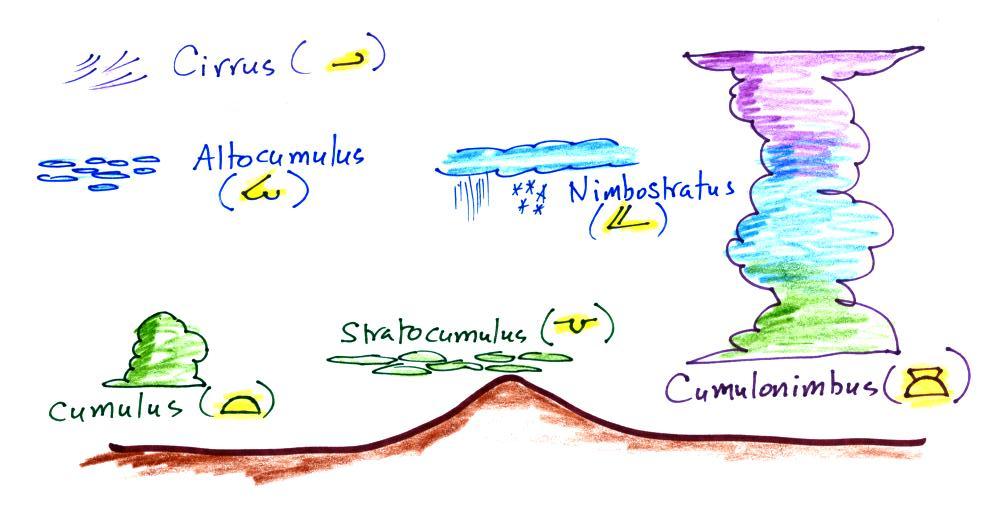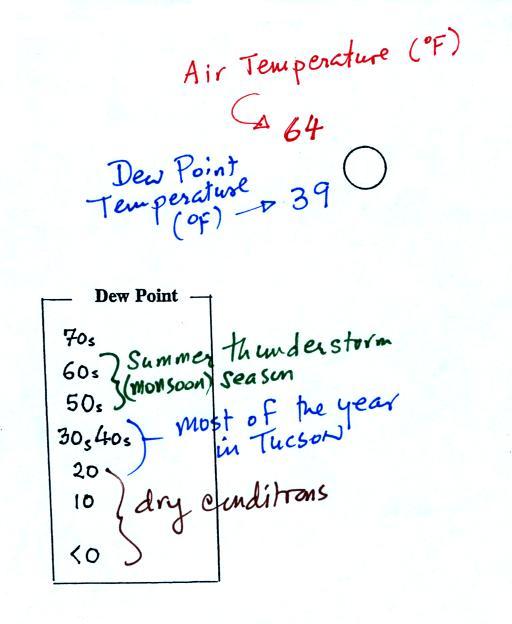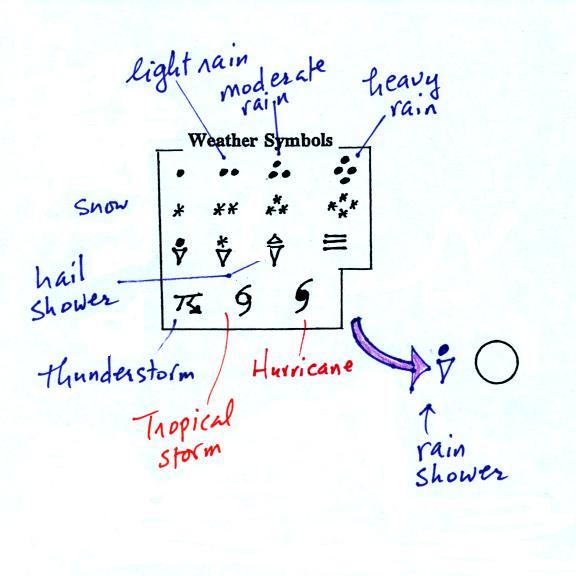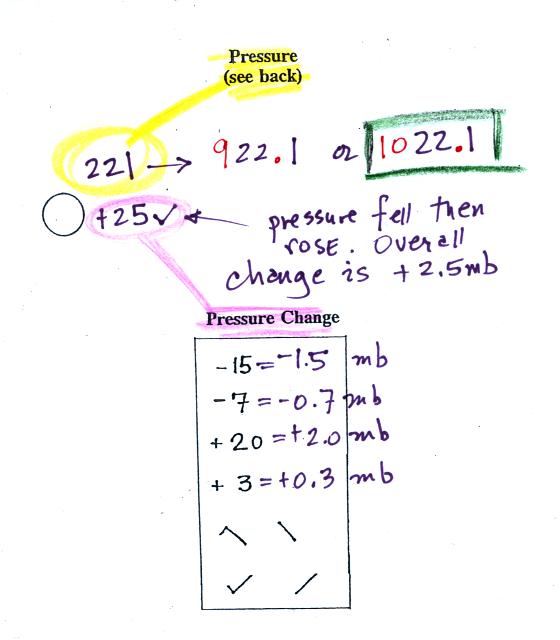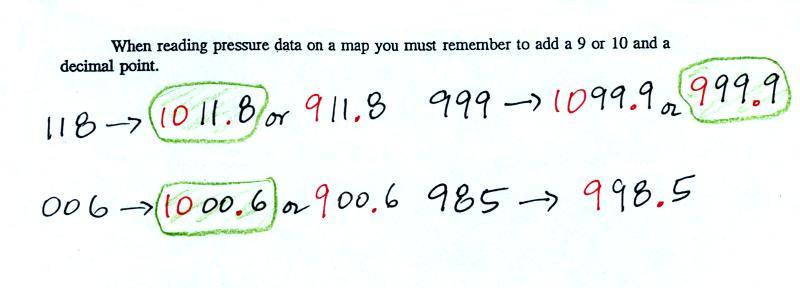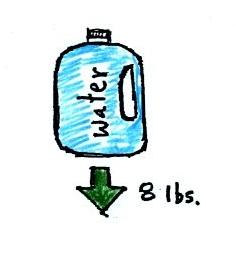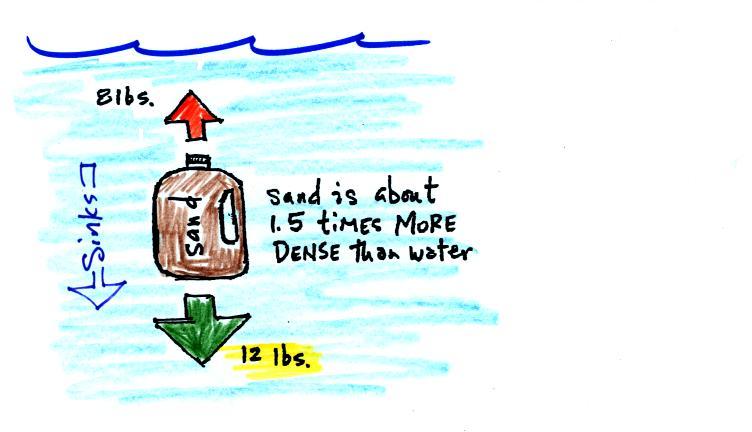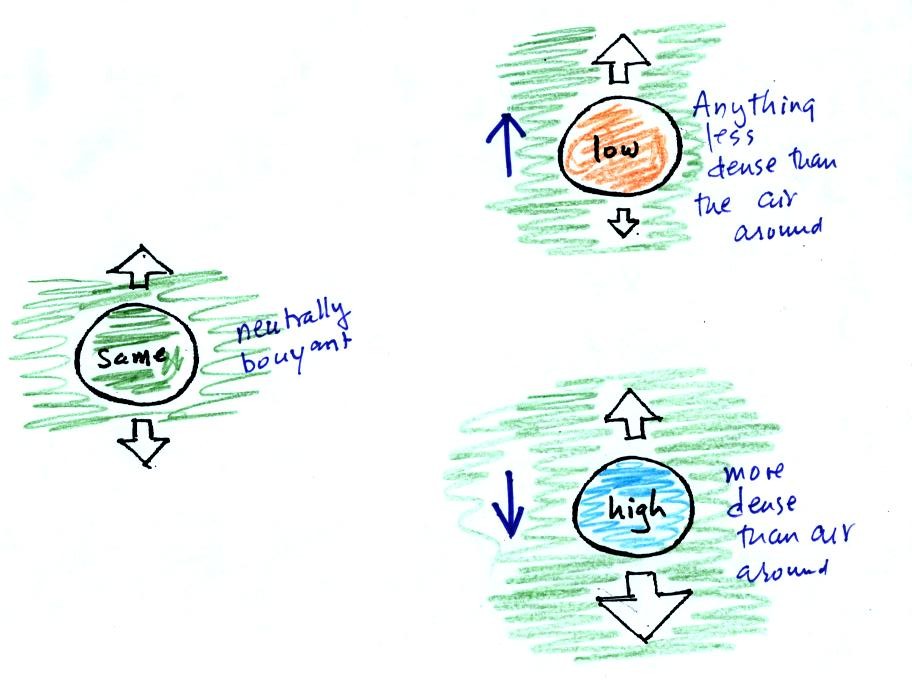Friday Sept. 16, 2011
click here to download today's notes in a more
printer friendly format
A few more songs from Calexico and Mariachi Luz de Luna before
class today ("Cancion
del
Mariachi" and "Aires
del
Mayab") I couldn't find a video of "Corona" from the concert
at the Barbican Theater in London so here's "El Cascabel" as
a replacement.
Unless noted otherwise, the Experiment #1
reports are due next Monday. Monday is also the due date for the 1S1P Bonus Report on Radon.
The In-class Optional Assignment from Monday was returned in class
today. Here are the answers.
We spent
most of today's class on a new topic -
Surface Weather Maps. We began by learning how
weather data are
entered onto surface weather maps.
Much of our weather is produced by relatively large
(synoptic scale)
weather systems - systems that might cover several states or a
significant fraction of
the continental US. To be able to identify and characterize these
weather systems you must first collect weather data (temperature,
pressure, wind direction and speed, dew point, cloud cover, etc) from
stations across the country and plot the data on a map. The large
amount of data requires that the information be plotted in a clear and
compact way. The station model notation is what meterologists
use.
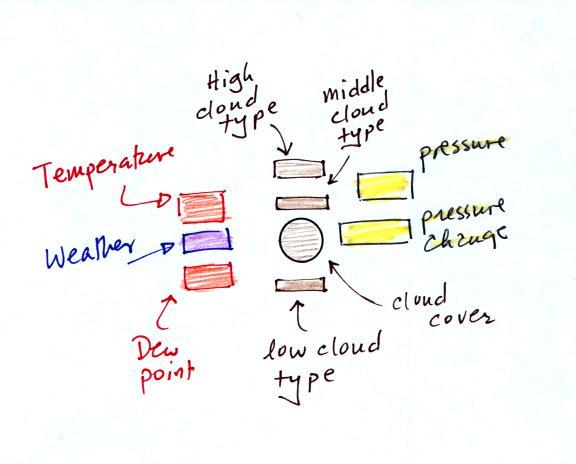
A small circle is plotted on the map at the location where
the
weather
measurements were made. The circle can be filled in to indicate
the amount of cloud cover. Positions are reserved above and below
the center circle for special symbols that represent different types of
high, middle,
and low altitude clouds. The air temperature and dew point
temperature are entered
to the upper left and lower left of the circle respectively. A
symbol indicating the current weather (if any) is plotted to the left
of the circle in between the temperature and the dew point; you can
choose from close to 100 different weather
symbols (on a handout distributed in class). The
pressure is plotted to the upper right of the circle and the pressure
change (that has occurred in the past 3 hours) is plotted to the right
of the circle.
We
worked through this material one step at a time (refer to p. 36 in
the photocopied ClassNotes). Some of the figures below were
borrowed from a previous semester or were redrawn and may differ
somewhat from what was drawn in class.
The center circle is filled in to indicate the portion
of
the sky
covered with clouds (estimated to the nearest 1/8th of the sky) using
the code at the top of the figure (which you can quickly figure
out). 3/8ths of the sky is covered
with clouds in the example above.
Then symbols are
used
to
identify
the
actual types of high, middle, and low altitude clouds observed in the
sky. Later in the semester we will learn the names of the 10
basic cloud types. Six of them are sketched above and symbols for
them are shown.
A complete list of cloud symbols was on a handout distributed in class
(a copy can be found here
) You do not, of
course, need to remember all of the cloud symbols.
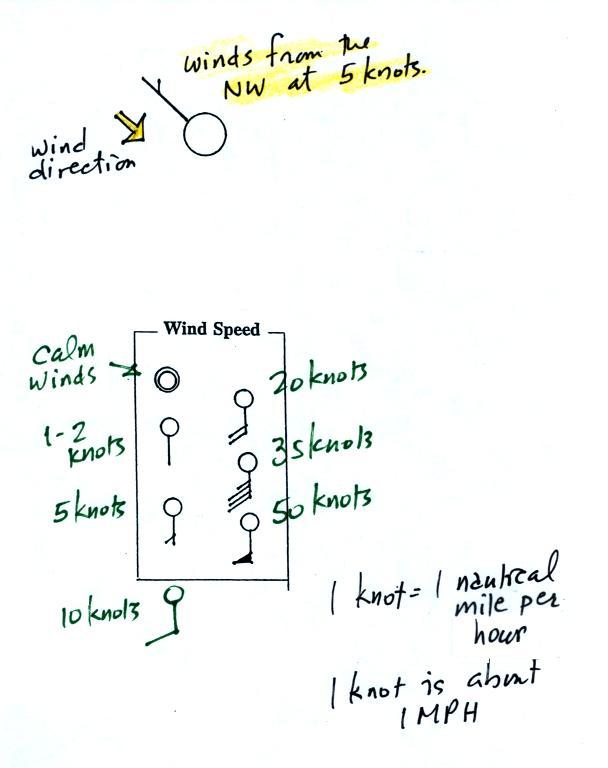
A straight line extending out from
the center circle
shows the wind direction. Meteorologists always give the
direction the wind is coming from.
In this example the winds are
blowing from the NW toward the SE at a speed of 5 knots. A
meteorologist would call
these northwesterly winds.
Small barbs at the end of the straight
line give the wind speed in knots. Each long barb is worth 10
knots, the short barb is 5 knots.
Knots are nautical miles per hour. One nautical mile per hour is
1.15 statute miles per hour. We won't worry about the distinction
in this class, we will just consider one knot to be the same as one
mile per hour.
Here are four more examples.
What is the wind direction and wind speed in each case. Click here
for
the answers.
The air temperature and the dew point temperature are probably the
easiest data to decode.
The air temperature in this example
was 64o
F
(this is
plotted above and to the left of the center circle). The dew
point
temperature was 39o F and is plotted below and to the left
of the center circle. The box at lower left reminds you that dew
points range from the mid 20s to the mid 40s during much of the year in
Tucson.
Dew
points rise into the upper 50s and 60s during the summer thunderstorm
season (dew points are in the 70s in many parts of the country in the
summer). Dew points are in the 20s, 10s, and may even drop below
0 during dry periods in Tucson.
And maybe the most interesting part.
A symbol representing the weather
that is currently
occurring is plotted to the left of the center circle (in between the
temperature and the dew point). Some of
the common weather
symbols are
shown. There are about 100 different
weather symbols that you can choose
from (click here
if you didn't get a copy of the handout distributed in class today).
There's no way I could expect you to remember all of those weather
symbols.
The pressure data is usually the most confusing and most difficult
data to decode.
The sea level pressure is shown above and to the right
of
the center
circle. Decoding this data is a little "trickier" because some
information is missing. We'll look at this in more detail
momentarily.
Pressure change data (how the pressure has changed during
the preceding
3 hours)
is shown to the right of the center circle. You must
remember to add a decimal point. Pressure changes are usually
pretty small. The pressure change
data wasn't mentioned in class.
Here's what you need to know about the pressure data.
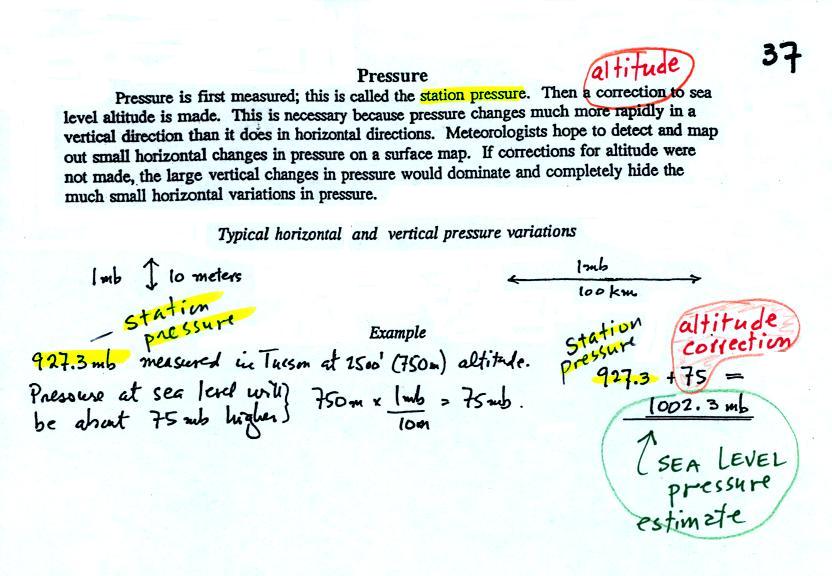
Meteorologists hope to map out small horizontal pressure
changes on
surface weather maps (that produce wind and storms). Pressure
changes much more quickly when
moving in a vertical direction. The pressure measurements are all
corrected to sea level altitude to remove the effects of
altitude. If this were not done large differences in pressure at
different cities at different altitudes would completely hide the
smaller horizontal changes.
In the example above, a station
pressure value of 927.3 mb was measured in Tucson. Since Tucson
is about 750 meters above sea level, a 75 mb correction is added to the
station pressure (1 mb for every 10 meters of altitude). The sea
level pressure estimate for Tucson is 927.3 + 75 = 1002.3 mb.
This sea level pressure estimate is the number that gets plotted on the
surface weather map.
Do you need to remember all the
details above and be able to calculate the exact correction
needed? No. You
should
remember that a correction for altitude is needed.
And the correction needs to be added to the station pressure.
I.e. the sea-level pressure is higher than the station pressure.
The calculation above is shown in a picture below
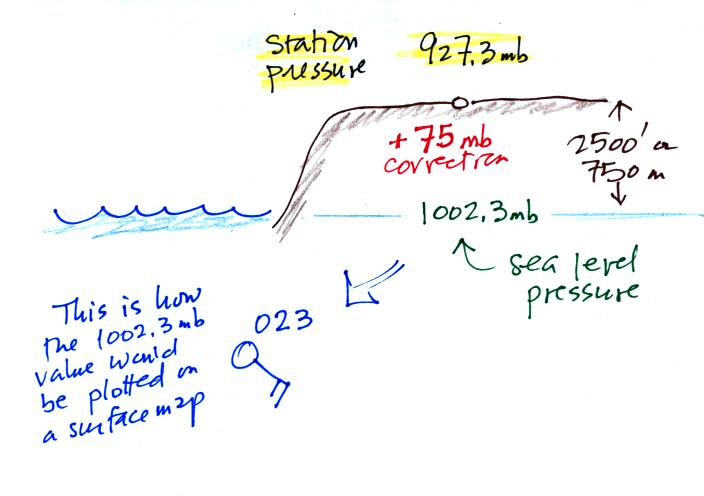
Here are some examples of coding
and decoding the pressure data.
First of all we'll take some sea level pressure values and show
what needs to be done before the data is plotted on the surface weather
map.
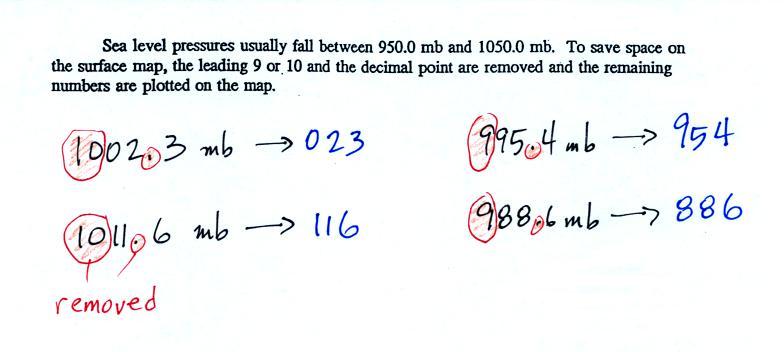
To save room, the leading 9 or 10
on the sea level pressure
value and
the decimal
point are removed before plotting the data on the map. For
example the 10 and the . in
1002.3 mb would
be removed; 023
would be plotted on the weather map (to the upper right of the center
circle). Some additional examples are shown above.
When reading pressure values off a
map you must remember to
add a 9 or
10 and a decimal point. For example
118 could be either 911.8 or 1011.8 mb. You pick the value that
falls between 950.0 mb and 1050.0 mb (so 1011.8 mb would be the correct
value, 911.8 mb would be too low).
We finished the day and the week
with a little information about
Archimedes Law. Last Wednesday we saw that the
relative
strengths of the
downward graviational force and the upward pressure difference force
determine whether a parcel of air will rise or sink. Archimedes
Law is another, somewhat simpler, way of trying to understand this
topic.
A gallon of
water weighs about 8 pounds (lbs).
If you submerge the gallon jug of water in a swimming pool, the
jug
becomes, for all intents and purposes, weightless. Archimedes'
Law (see figure below, from p. 53a in the photocopied ClassNotes)
explains why this is true.
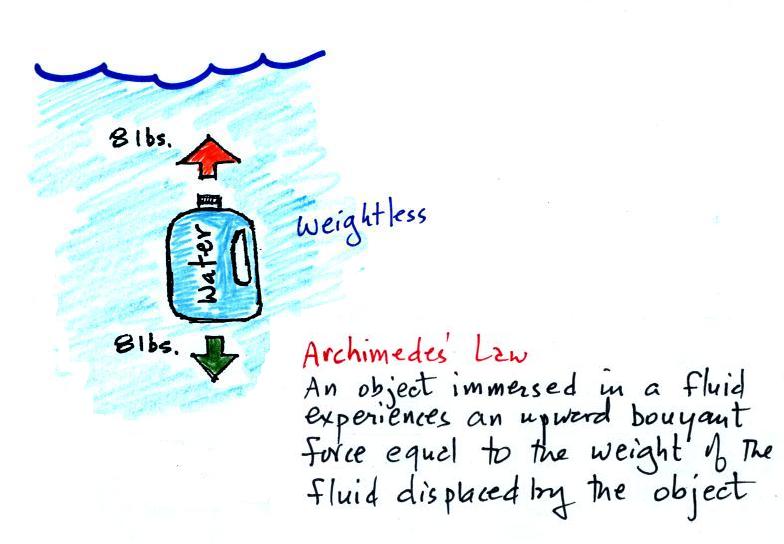
Archimedes first of all tells you
that the surrounding fluid will exert an upward pointing bouyant force
on the submerged water bottle. That's why the submerged jug can
become weightless. Archimedes law also tells you how to figure
out how strong the bouyant force will be. In this
case the 1 gallon bottle will displace 1 gallon of
pool water. One
gallon of pool
water weighs 8 pounds. The upward bouyant force will be 8 pounds,
the same as the downward force. The two
forces are equal and opposite.
Archimedes law doesn't really tell you what causes the upward
bouyant
force. If you're really on top of this material you will
recognize that it is really
just another name for the
pressure difference force that we covered last Friday (higher pressure
pushing
up on the bottle and low pressure at the top pushing down, resulting in
a net upward force).
Now we imagine pouring out all the water and filling the 1 gallon
jug
with air. Air is about 1000 times less dense than water;compared
to water, the jug
will weigh practically nothing.
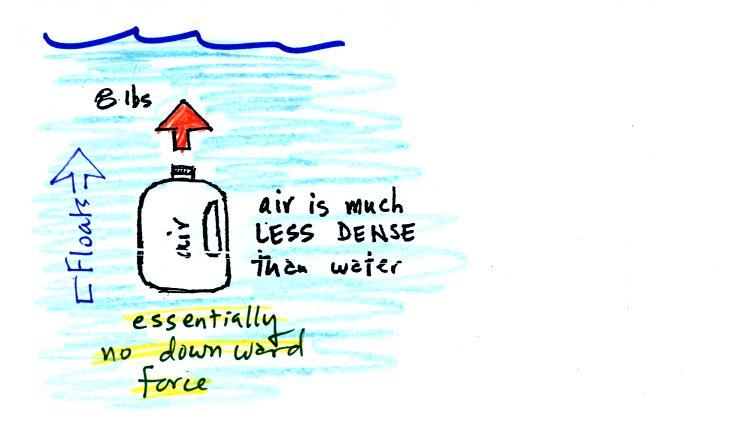
If you
submerge the jug of air in a
pool
it will displace 1 gallon of
water
and experience an 8 pound upward bouyant force again. Since there
is no downward force the jug will float.
One gallon of sand (which is about 1.5 times denser than water)
jug weighs 12 pounds (I try to give you accurate information and
actually checked
this out).
The jug of sand will sink because
the downward force is greater
than
the upward force.
You can sum all of this up by saying anything that is less dense
than
water will float in water, anything that is more dense than water will
float in water.
The same reasoning applies to air in the atmosphere.
Air that is less dense (warmer)
than the air around it will
rise.
Air that is more dense (colder) than the air around it will sink.
Here's a little more
information
about
Archimedes that I didn't mention in
class.
There's a colorful demonstration that shows how small differences
in density
can determine whether an object floats or sinks.
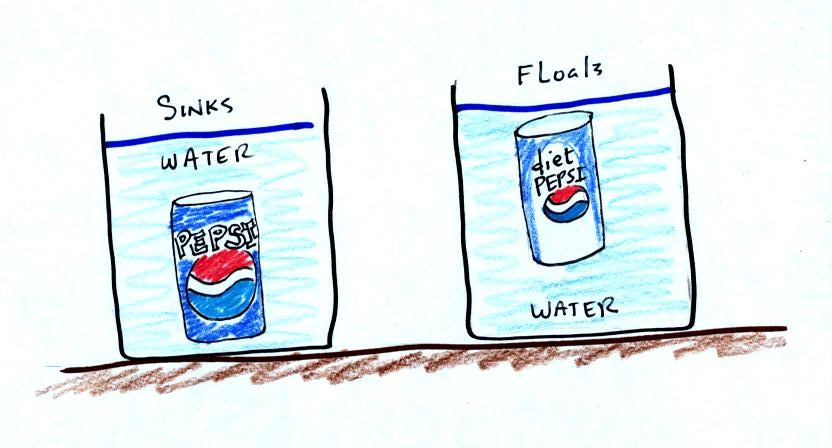
A can of regular Coca Cola was
placed in a beaker of water.
The
can
sank. A can of Diet Coke on the other hand floated.
(Coke was used instead of Pepsi because Coke now has the exclusive
franchise
on the U. of A. campus)
Both cans are made of aluminum which has a density almost three
times
higher than water. The drink itself is largely water. The
regular Coke also has a lot of high-fructose
corn
syrup, the diet Coke
doesn't. The mixture of water and corn syrup has a density
greater than plain
water. There is also a little air (or perhaps carbon dioxide gas)
in each can.
The average density of the can of regular Coke (water & corn
syrup
+
aluminum + air) ends up being slightly greater than the density of
water. The average density of the can of diet Coke (water +
aluminum + air) is slightly less than the density of water.
I sometimes repeat the "demonstration" with a can of Pabst Blue
Ribbon
beer. This also floats because the beer doesn't contain any corn
syrup
(I don't think).
In some respects people in swimming pools are like cans of regular
and
diet soda. Some people float (they're a little less dense than
water), other people sink (slightly more dense than water).
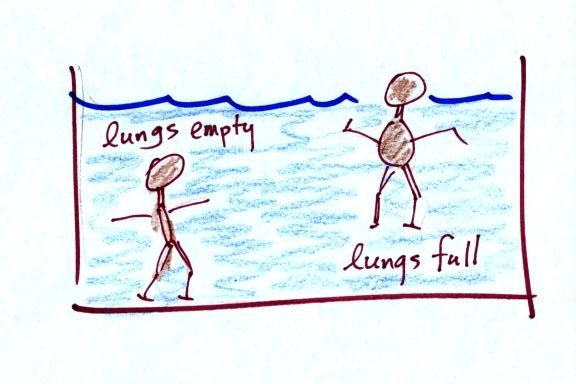
Many people can fill their lungs
with air and make themselves
float, or
they can empty their lungs and make themselves sink. People have
an average density that is about the same as water. That makes
sense because we are largely made up of water (water makes up about 60%
of human males and 55% of human females according to this source)



